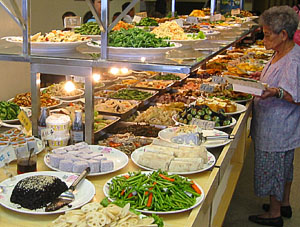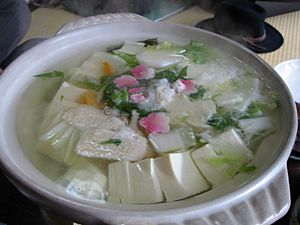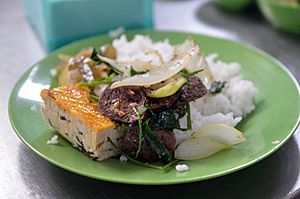Buddhist cuisine facts for kids
Quick facts for kids Buddhist vegetarian cuisine |
|||||||||||||||||||
|---|---|---|---|---|---|---|---|---|---|---|---|---|---|---|---|---|---|---|---|

A vegetarian restaurant in Taipei, Taiwan serving Buddhist cuisine in buffet style
|
|||||||||||||||||||
| Chinese name | |||||||||||||||||||
| Traditional Chinese | 齋菜 | ||||||||||||||||||
| Simplified Chinese | 斋菜 | ||||||||||||||||||
|
|||||||||||||||||||
| Vietnamese name | |||||||||||||||||||
| Vietnamese alphabet | đồ chay | ||||||||||||||||||
| Korean name | |||||||||||||||||||
| Hangul | 사찰음식 | ||||||||||||||||||
| Hanja | 寺刹飮食 | ||||||||||||||||||
|
|||||||||||||||||||
| Japanese name | |||||||||||||||||||
| Kanji | 精進料理 | ||||||||||||||||||
| Kana | しょうじんりょうり | ||||||||||||||||||
|
|||||||||||||||||||
| Filipino name | |||||||||||||||||||
| Tagalog | Lutuing Budista | ||||||||||||||||||
| Khmer name | |||||||||||||||||||
| Khmer | ម្ហូបព្រះពုဒ္ឍសាសនា | ||||||||||||||||||
Buddhist cuisine is a special way of cooking from Asia. It is followed by monks and many people who believe in Mahayana Buddhism. This type of food is usually vegetarian or vegan. It is based on the idea of ahimsa, which means not harming any living thing.
Eating vegetarian is also common in other religions like Hinduism, Jainism, Sikhism, and Taoism. While some monks and believers eat vegetarian all year, many others follow this diet for special celebrations.
The idea of "Buddhist food" started in monasteries. Here, one person was in charge of cooking meals that followed Buddhist rules. Some temples even had restaurants for visitors. In Japan, this cooking style is called shōjin ryōri (精進料理). It means "devotion cuisine" and is served at many temples, especially in Kyoto. Today, many restaurants also offer Buddhist-style food for everyone.
Contents
What Guides Buddhist Food?
Why Buddhists Eat Vegetarian
Most Buddhist dishes are vegetarian. However, not all Buddhist groups require everyone to be vegetarian. Eating vegetarian is most common in East and Southeast Asia, like China, Vietnam, Japan, and Korea. Monks often eat this way, and other followers might do so on holidays.
In Mahayana Buddhism, some old texts say that people should not eat meat. Because of this, monks and nuns in Chinese, Vietnamese, and most Korean Buddhism strictly avoid meat.
Theravada monks and nuns usually get their food by asking for alms (donations). They generally eat whatever food is given to them, even if it is meat. But there is one important rule: they cannot eat meat if they know an animal was killed just for them. They also avoid meat from certain animals like dogs or snakes. Some regular Buddhists follow a similar rule, eating only "triply clean meat." This means the animal was not killed for them, they did not see it killed, and they did not hear it killed.
In Tibetan Buddhism, it can be hard to find vegetables in Tibet. So, it's not always possible for everyone to be vegetarian. Still, many Tibetan Buddhist teachers believe that being vegetarian is a good thing to do whenever possible.
Both Mahayana and Theravada Buddhists believe that eating vegetarian can help them grow in their spiritual journey.
Other Food Rules

Besides avoiding meat, many Buddhist monks in China, Korea, Vietnam, and Japan also avoid strong-smelling plants. These include garlic, asafoetida, shallot, mountain leek, and Allium chinense. These are called the "Five Acrid and Strong-smelling Vegetables." They are avoided because they are thought to excite the senses. Today, this rule often includes other plants from the onion family, like regular onions, and sometimes coriander.
For Buddhists who are not strict vegetarians, there are still some rules. Many Chinese Buddhists avoid beef and meat from large or unusual animals. They also follow the "triply clean meat" rule mentioned earlier. Another rule is to avoid eating animal offal, which means organ meat.
Simple and Natural Cooking
Buddhist cooking is often simple and natural. Cooks try to make the most of the ingredients they have. They focus on making food that is good for you, healthy, and tasty. Even with a small budget, monastery cooks make sure the food is prepared with care.
A famous Zen master named Eihei Dogen wrote about how Zen Buddhists should think about food. He said that when you prepare food, you should be sincere and respect every ingredient. It doesn't matter if the food is fancy or simple. He believed that the true taste of the food comes from how mindfully it is prepared and eaten.
Common Ingredients
Rice is a very important food in Buddhist meals, especially in East Asia. It is often eaten as rice porridge, called congee, for breakfast. Noodles and other grains are also common.
All kinds of vegetables are used. They are often stir-fried or cooked in a vegetarian broth with different seasonings. Traditionally, eggs and dairy products are not allowed. The seasonings used depend on the local area. For example, soy sauce is common in Japanese monastery food. In Southeast Asia, curry and Tương (a vegetarian sauce like fish sauce) might be used. Sweets are not eaten often but are allowed in small amounts for special events.
Buddhist vegetarian chefs are very creative. They can make vegetarian foods that look and taste like meat. They often use wheat gluten (also called seitan or wheat meat) and soy products like tofu or tempeh. They also use agar and konnyaku. These ingredients are great because they can be shaped in many ways and soak up flavors. With the right seasonings, they can taste very much like different kinds of meat.
Many monasteries and temples have chefs who make these mock-meat dishes for monks and visitors. Many Buddhist restaurants also serve vegetarian, vegan, and allium-free meals.
Some Buddhists eat vegetarian on specific days, like the 1st and 15th of the lunar calendar. To serve these customers, Buddhist vegetarian restaurants often have menus that look like regular Chinese or East Asian restaurants. The only difference is that they use soy or wheat substitutes instead of meat.
How Meals Are Served
In the Zen tradition, formal monastery meals often use three bowls of different sizes. The largest bowl holds a grain dish like rice, noodles, or congee. The second bowl has a protein dish, often a stew or soup. The smallest bowl is for a vegetable dish or a salad.
Images for kids
-
An example of shōjin-ryōri taken in Kyoto, Japan, at the zen temple of Ryōan-ji.
See also
 In Spanish: Gastronomía budista para niños
In Spanish: Gastronomía budista para niños





